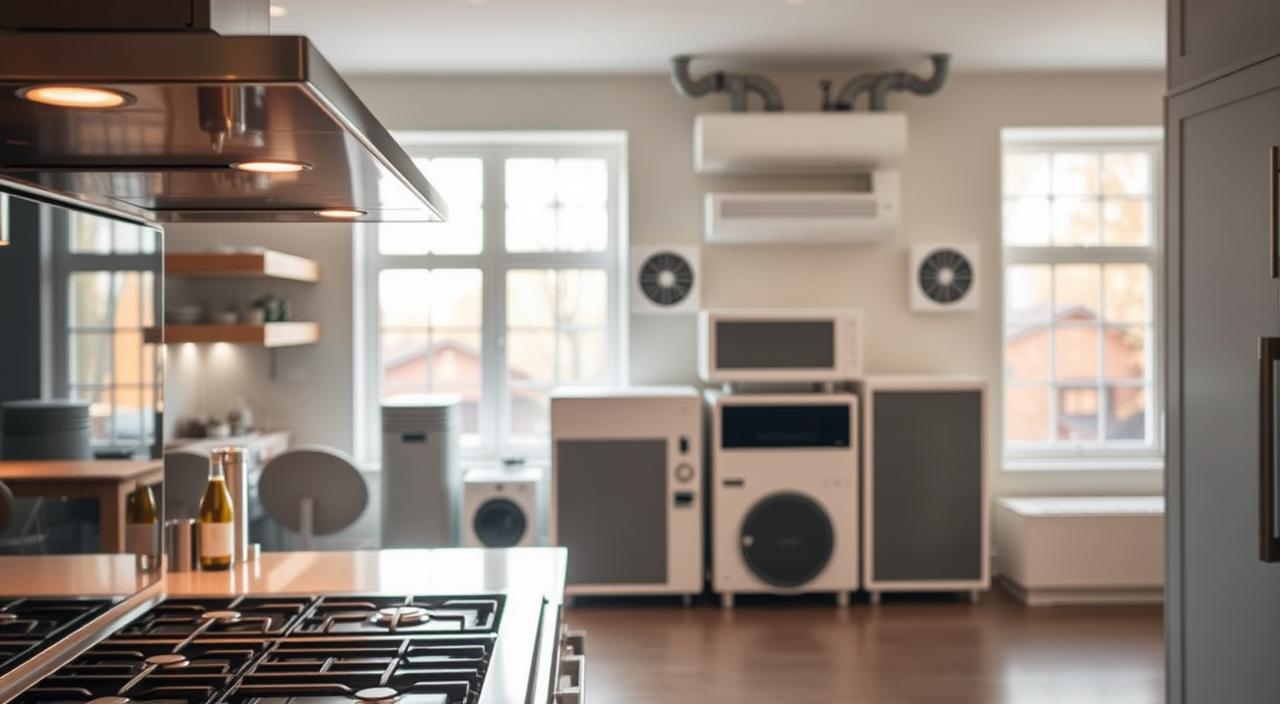Your bedroom should feel like a calm retreat, not a storage unit. Yet, for many Londoners, limited space leads to overfilled wardrobes and crowded surfaces that silently affect rest and wellbeing. Recent research reveals that clutter and sleep quality are closely connected — and that messy rooms can trap pollutants that impact breathing throughout the night.

This guide explores how overcrowded spaces harm indoor air, what contaminants you may not notice, and practical steps to restore freshness and peace to your bedroom environment.
🧭 Key Takeaways
- Clutter traps dust, mould spores, and allergens that reduce air quality.
- Overstuffed wardrobes block airflow and worsen humidity.
- Cleaner air improves respiratory health and reduces night-time congestion.
- Ventilation and minimalism can transform your sleep environment.
- Regular decluttering supports long-term wellbeing and relaxation.
Understanding the Link Between Clutter and Sleep Quality
Clutter is more than an eyesore — it’s an environmental and psychological stressor. When your room feels chaotic, your brain perceives it as unfinished work. This raises cortisol levels and makes it harder to relax before sleep.
Physically, tightly packed belongings trap microscopic particles that irritate your airways. Dust mites, pet dander, and mould spores thrive in confined, poorly ventilated spaces. Over time, these pollutants contribute to blocked sinuses, coughing, and disturbed rest.
A study from the Sleep Foundation found that people who sleep in tidy bedrooms fall asleep faster and report higher rest satisfaction compared to those surrounded by visible clutter.
The Hidden Air Pollutants Inside Cluttered Bedrooms

City living often means battling both outdoor and indoor pollution. In London, fine particulate matter from vehicles and industry easily drifts indoors, combining with emissions from furniture and household products.
| Source | Typical Pollutant | Effect on Health |
|---|---|---|
| Soft furnishings & wardrobes | Dust, mould, allergens | Night-time congestion, sneezing |
| Cleaning products | Volatile Organic Compounds (VOCs) | Headaches, irritation |
| Gas appliances | Nitrogen oxides, carbon monoxide | Respiratory problems |
| Furniture coatings & paint | Formaldehyde | Long-term sensitivity |
Even low levels of these substances can cause irritation, especially in people with asthma or allergies. Overfilled wardrobes worsen the situation by trapping warm, stagnant air that encourages pollutants to build up.
Why Overstuffed Wardrobes Restrict Air Circulation
A crowded wardrobe creates physical barriers that block natural airflow. Fabric surfaces absorb dust and pollutants, then release them back into the air when disturbed.
When clothes are tightly packed, they prevent convection currents from circulating through the room. Stale air accumulates, and humidity rises — ideal conditions for mould growth.
To counter this, leave gaps between garments and avoid pushing storage units against walls. If possible, choose open or slatted furniture that allows air to pass freely behind and beneath shelves.
Mental and Physical Benefits of Decluttering
Tidying your environment does more than clear space — it supports your mental and physical health. Decluttering can:
- Reduce anxiety and promote calm before sleep
- Improve airflow, reducing allergen buildup
- Simplify cleaning and maintenance
- Help identify damp or hidden mould problems
- Encourage more intentional living habits
According to researchers at the University of California, people with cluttered bedrooms had higher levels of the stress hormone cortisol throughout the evening. This made it harder to unwind and achieve deep, restorative sleep.
Step-by-Step Decluttering Plan for Better Air
Start small — one surface or drawer at a time. Gradual progress prevents overwhelm and builds sustainable habits.
- Empty and sort: Remove all items from wardrobes and drawers.
- Assess usefulness: Donate or recycle anything not used in the past year.
- Clean thoroughly: Wipe shelves and vacuum corners using a HEPA filter.
- Reorganise smartly: Keep seasonal clothes accessible and store extras in breathable fabric bags.
- Maintain balance: Follow the “one in, one out” principle to prevent re-cluttering.
By reducing excess fabric and dust sources, you allow cleaner air to circulate and improve your nightly rest.
Improving Ventilation and Reducing Moisture
Poor airflow and excess humidity are the main causes of indoor pollution and disturbed sleep. In London’s older homes, these issues are often compounded by sealed windows and insulation designed to retain heat.
Simple airflow improvements include:
- Opening opposite windows for 10 minutes daily to create cross-ventilation.
- Using extractor fans in kitchens and bathrooms to prevent damp air spreading.
- Installing trickle vents to ensure continuous background airflow.
- Keeping wardrobe doors ajar occasionally to release trapped humidity.
Maintaining indoor humidity between 40–60% reduces dust mites and mould while keeping air comfortable to breathe.
How Heating and Cleaning Habits Affect Bedroom Air

Gas heating and aerosol cleaning products are surprisingly large contributors to indoor pollution. They release nitrogen oxides and VOCs, which linger longer in closed spaces.
When cleaning or using sprays, always ventilate the area. Opt for eco-certified, fragrance-free products that contain fewer chemicals. Natural alternatives like vinegar and baking soda work well for most surfaces and emit no harmful gases.
For extra protection, use a HEPA air purifier to trap particulates and allergens — particularly beneficial in small city flats.
Reducing Damp, Dust, and Allergens
Regular cleaning and humidity control make a major difference in air quality. The table below summarises the most effective practices:
| Task | Frequency | Benefit |
|---|---|---|
| Vacuum with HEPA filter | Weekly | Removes fine dust and allergens |
| Wash bedding at 60 °C | Fortnightly | Eliminates dust mites |
| Wipe surfaces with damp cloth | Weekly | Captures settled particles |
| Use dehumidifier or open window | As needed | Prevents mould growth |
Avoid drying laundry indoors where possible, as this releases large amounts of moisture. If unavoidable, keep a window slightly open or run a dehumidifier to offset the effect.
Choosing Furniture That Supports Clean Air
Furniture choices have a long-term influence on your home’s environment. Low-emission designs minimise VOC release and improve airflow.
- Select solid wood furniture instead of chipboard or MDF.
- Look for FIRA Gold or Greenguard certifications for lower chemical emissions.
- Allow new furniture to “off-gas” outdoors or in a garage for a few days before use.
- Leave small gaps between furniture and walls to prevent damp buildup.
If you’re updating storage, consider open shelving or modular wardrobes with space beneath for cleaning and airflow.
Supporting Respiratory Health at Home
For people with asthma or chronic respiratory issues, managing indoor air quality is especially critical. Pollutants can trigger flare-ups and reduce medication effectiveness.
Simple steps such as regular vacuuming, airing bedding, and maintaining consistent temperature and humidity can greatly reduce symptoms.
The British Lung Foundation offers guidance on maintaining healthy air at home and recommends regular servicing of gas appliances to limit emissions (see their advice).
Addressing Urban Air Challenges in London Homes
Londoners face unique challenges due to the city’s high external pollution levels. Even when you close your windows, ultrafine particles can seep through gaps and ventilation systems.
Those living near major roads are particularly exposed. Combining city pollutants with indoor clutter multiplies risks. The best defences are clean, breathable interiors, houseplants that filter air, and well-maintained ventilation.
For further insight into eco-conscious living in the capital, visit Rubbish Removal London’s sustainable living blog, which offers practical home-cleaning and decluttering advice for urban households.
Energy Efficiency Without Compromising Air Quality
Efficient heating shouldn’t mean sealing your home airtight. Good insulation paired with balanced ventilation maintains warmth while reducing pollution.
- Schedule annual checks for gas systems by a Gas Safe registered engineer.
- Use thermostats to maintain comfortable temperatures above 18 °C.
- Install draught excluders to prevent unnecessary heat loss.
- Combine insulation improvements with regular air exchange.
Design and Organisation Ideas for a Breathable Bedroom
Minimalist design isn’t about removing personality — it’s about freeing up space for health and comfort.
- Choose furniture with legs to allow air to circulate underneath.
- Avoid floor-to-ceiling storage units that block airflow.
- Use natural fibres such as cotton and linen to reduce static and dust.
- Limit decorative textiles that attract particles, like heavy curtains or cushions.
- Maintain a capsule wardrobe of essentials to simplify choices and reduce clutter.
Small design changes can dramatically improve how “light” and fresh your room feels.
🌙 Conclusion
Healthy sleep begins with a clean, well-ventilated environment. The link between clutter and sleep quality is undeniable — tidier rooms promote deeper rest, better breathing, and calmer minds.
Through simple decluttering routines, mindful cleaning practices, and improved ventilation, you can transform your bedroom into a true sanctuary. Over time, these small daily habits safeguard not only your sleep but also your long-term wellbeing.

